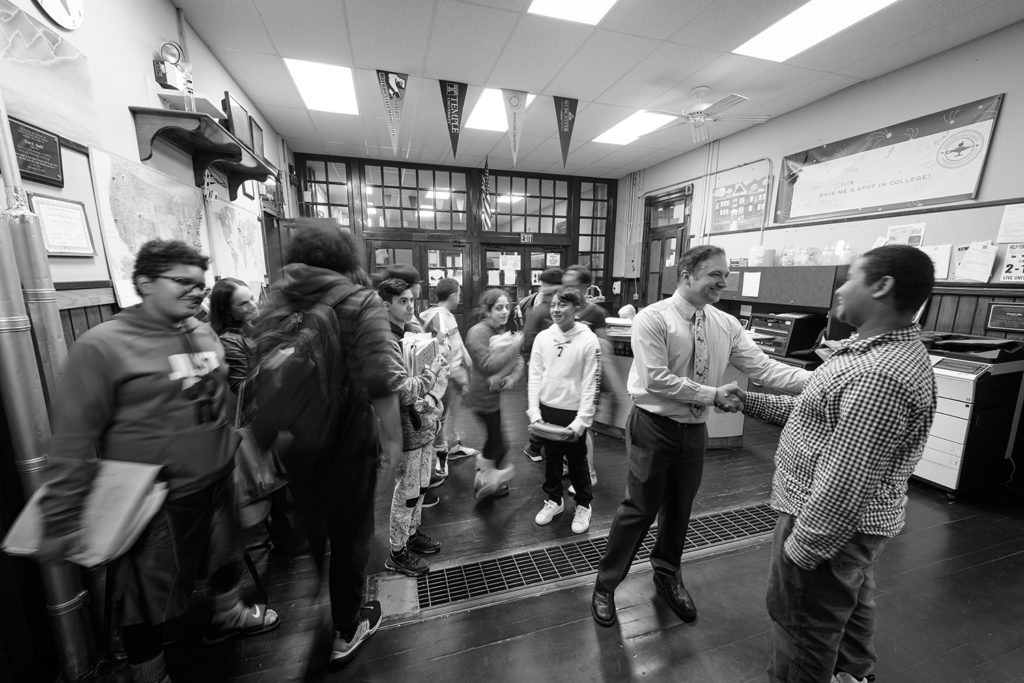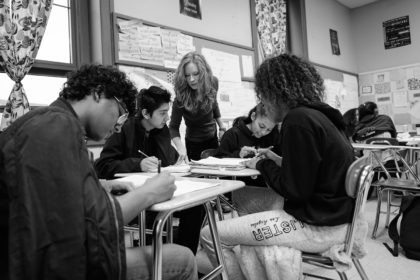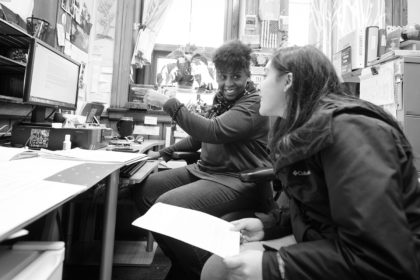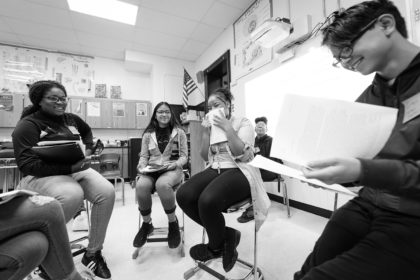A promise kept: University Park Campus School marks 20 years

University Park Campus School opened in 1997 as “The School With a Promise” that would help lift children from the Main South neighborhood toward dreams and ambitions once deemed beyond their reach. The tagline was impressive, and the mission daunting.
That promise was no empty pledge. Now in its 20th year, UPCS has cemented its reputation as one of the country’s finest public schools and a model for town-gown partnership. The school has garnered accolades from Massachusetts governors and education secretaries, education reform pioneers, and national publications. Even President Barack Obama hailed the school’s success in a 2011 pitch to revamp national education standards.

Today, University Park Campus School serves 250 students in grades seven to 12, 80 percent of whom qualify for free and reduced lunch and another 70 percent who don’t speak English as a first language. Despite these challenges, the 10th graders typically meet or outperform state and district averages on testing, and the school boasts a 100 percent graduation rate. You can count on one hand the number of those graduates who did not go on to college in the last two decades. Qualifying UPCS students attend Clark tuition-free, a pact the University has made with the neighborhood residents.
“This is a scenario right out of the movie ‘It’s a Wonderful Life,’” marvels Jack Foley, Clark’s vice president of government and community relations. “You have to ask the question: What would have happened to these kids without that school?”
There is history at work here. In the 1980s, Clark University found itself increasingly isolated from the neighborhood around it. Families fled the Main South area, leaving behind empty three-deckers and rising crime rates. School administrators worried that Clark’s campus would end up an island surrounded by blighted buildings among a neighborhood that viewed the University with distrust and skepticism.
From this dilemma was born the University Park Partnership, first sketched out on a napkin during a lunch meeting between then-Clark President Richard Traina and Foley. The partnership evolved into a mission for neighborhood stakeholders — Clark, the city of Worcester and community groups — to transform the area around the University through the rehabilitation of housing and commercial spaces, economic development, public safety and recreational activities for area residents.

By the mid-1990s, Clark, with its newly christened Hiatt Center for Urban Education, began exploring ways to influence the educational opportunities afforded to neighborhood families and once again found a willing partner in Worcester. It’s most fitting that the UPCS story be told by those instrumental in its creation and success: the teachers who have dedicated their careers to the school, the students who have walked through its doors, and the Clark University administrators who insisted that what was good for the children of Main South was good for Clark, for Worcester, and for the wider world.
Jack Foley
Our premise was: How do you create a strong community that will work together to rejuvenate this area? [Worcester Public Schools Superintendent] James Garvey was interested because of concern about the dropout rate. We thought working on local education would be a major piece of our effort to attract families and create stability in the neighborhood.
Tom Del Prete
Director of the Adam Institute for Urban Teaching and School Practice at Clark
Jim Garvey’s thinking was partially prompted by the introduction of the Hiatt Center to Clark. The Center was meant to be a way to connect the University with schools — to bring the tools of university research methods to teachers and be a collaborating resource. There was some risk in going out into the neighborhood because the University at the time had no real relationship with the people in the community. This would be rebuilding our identity through social engagement in a way that was more than an abstract idea — it was real.
Jack Foley
There were some disagreements at Clark about whether University Park should be a lab school, a public school, or an exam school. At the end of the day, we were able to reach consensus: This would be a school run by the Worcester Public Schools, partnering closely with Clark on professional development enhancements and other ways to make it successful. University Park Campus School would be open to anybody who lived in the neighborhood, and admission would be by lottery.
♦♦♦♦
By 1996, Clark and Worcester settled on a location for the new school — the old Downing Street School building, now the Traina Center for the Arts — and got to work recruiting faculty and seventh-graders for the 1997-1998 school year. Donna Rodrigues, a longtime teacher at South High School and neighborhood resident, was chosen as the school’s first principal. In September 1997, with the help of $390,000 Clark had received as part of a Housing and Urban Development grant, University Park Campus School opened its doors.
June Eressy
Former UPCS teacher; principal from 2003 to 2009
At the time UPCS was founded I was an English teacher at South High and Donna Rodrigues was my colleague and my friend. She told me about the idea of UPCS starting and asked me to apply to be the English teacher. I remember people saying, “Oh, that school will only last a couple years and then they’ll get rid of it.” I had a conversation with Donna and Dermot Shea, who was the other founding faculty member, and we agreed that we had to make this school beyond excellent so that there would be no way that we’d be shut down. We went all in.
Kimberly Surrette ’08, MAT ’09
UPCS Class of ’04, teacher at Claremont Academy
My dad brought me to the informational meeting when I was a sixth grader, and I really didn’t want to go. I specifically remember having arguments with him about how it was the “smart-kids school.” He made me dress up in a skirt — I could tell it was very important. And later it came full circle because when my little brother Ben was going into seventh grade, I ended up bringing him to his UPCS informational meeting.
Sarah Marcotte, ’98, M.A.Ed. ’99
19-year UPCS history teacher
It was strange then because UPCS wasn’t a full school, just seventh and eighth graders. It felt different — it felt small. We didn’t have a gym, so we would have intramurals at 6 a.m. at Clark before school. Classes were an hour and a half. When a kid had to go to the dentist, you brought them to the dentist. We didn’t really have a guidance counselor or nurse — we did a lot of those things ourselves.
♦♦♦♦
 Two years later, UPCS moved into its current building, the former Freeland Street School just down the road from Clark. By 2003, the school was at capacity — a middle school/high school serving 240 students from the immediate neighborhood around Clark.
Two years later, UPCS moved into its current building, the former Freeland Street School just down the road from Clark. By 2003, the school was at capacity — a middle school/high school serving 240 students from the immediate neighborhood around Clark.
Damian Ramsey
UPCS’s first valedictorian; assistant principal at Kipp Atlanta Collegiate High School
Whenever Donna Rodrigues walked into a room, we all straightened up. It was automatic. There were times when neighborhood kids would have problems with some of our students, and she would stand at the corner of Freeland Street and Main Street, making sure that we got home safely. I remember I had a new bike my mom bought me, and I would ride it to school in the mornings. Some guy came in and stole it. I was heartbroken, and Donna Rodrigues wouldn’t have it. She bought me a Diamondback, brand new, no questions asked.
Ricci Hall ’97, M.A.Ed. ’98
Former UPCS teacher; principal from 2009 to 2012; principal of Claremont Academy
The school grew quickly, but it also allowed us to build from the bottom up — and that allowed us to set up a significant culture from the beginning. When June became principal and we started to get some national notoriety, success begat success, and the kids adopted the same approach the teachers did, which was, “We don’t want this thing to fall down on our watch.” So there was this almost natural intensity to say we want to continue to do well and build upon what our predecessors had built.
June Eressy
The first group, the legacy class, set the standard for the classes to come. The older kids really take the responsibility of bringing the younger kids into the fold. I think it also helps that we have a policy of accepting siblings because not only are the kids indoctrinated into the culture of the school but the families are as well. Always being respectful of the families and their circumstances really set UPCS apart from other schools because every issue became our issue, whether it was housing or incarceration or other issues that come with poverty.
Damian Ramsey
I grew up in a single-parent home and I struggled with my own anger and frustrations around life’s circumstances. But at University Park, I had great teachers, great counselors and great role models around me who helped guide my path. I was pushed to my maximum potential, and as a result, I excelled. As a junior, I could take classes at Clark. Through the Bruce Wells Scholars Program, I was able to live on campus over the summer and take additional classes. Those two things worked hand in hand to give me exposure to university life. When I went on to Brown University, I was able to feel more comfortable on campus as a first-generation college student and first-generation college student of color.
Dan St. Louis ’00, M.A.Ed. ’01
Current UPCS principal and former UPCS teacher
Most of us are Clark grads and came out of the Clark education program. We understood that kids deserve to participate in an all-Honors and Advanced Placement curriculum regardless of their previous academic experience or proficiency in English. They can still do algebraic thinking even if they haven’t totally memorized their times tables. They can interact with their English teachers around a complex play or poem or novel even if their spelling or grammar is not yet perfect. They deserve to reach for these higher things. Kids from this neighborhood can take for granted that they can study at high levels and go on to college and good jobs.
♦♦♦♦
Today, former UPCS students have returned to the school to learn to teach, and now children of former students are starting to enroll. Clark’s presence also is felt strongly in nearby Claremont Academy, Woodland Street School, and Goddard Elementary School. Like UPCS, they are filled with Clark alumni as teachers and principals, and with current Clark students who are in training to enter the education field — a “K-16 campus” for neighborhood children, who can progress from kindergarten all the way to earning a Clark degree.
Tom Del Prete
What we’ve done is dissolve the boundaries between the University, the school, and the neighborhood. It feels natural for the kids to be here. We’re all part of the same educational community. That’s the most powerful thing that we’ve set in motion, and it’s made the difference.
Jyselle Cruz ’20
UPCS Class of 2016
All throughout high school, I did my homework at Clark. And now I do my homework here because I go here. At orientation when I got my schedule, they said, “Do you need help finding your classes?” and I said, “No, I know where each building is. I got it.” There’s an education course here where you have to sit in a class either at South High School, Claremont Academy or UPCS. Last semester, I sat in on a 10th-grade class at Claremont, and I plan to take more education classes that will put me in more classrooms.
Chau Nguyen ’12, UPCS Class of ’03
Intensive care nurse at St. Vincent Hospital, Worcester
My son attends UPCS now and he loves it there. He loves how he can just go to Clark with his friends and use the Clark library. One of his friends does a lot of dancing, and they’re able to use one of Clark’s dance rooms. It’s every parent’s hope that their kids will do better than them, or at least follow in their footsteps. I’m not pushing my son to become a doctor or engineer — I just want him to have a good and kind heart. And I’m hoping he’ll go to Clark University.
♦♦♦♦
The good work continues. Thanks in great part to its work at UPCS and other Main South schools, Clark in 2010 received a $14.2 million gift from the late Jack Adam to create the Adam Institute for Urban Teaching and School Practice. The Hiatt Center and Adam Institute advance Clark’s efforts in urban education, with University Park Campus School serving as an enduring model for success.
Jack Foley
Most university-neighborhood partnerships are viewed from the perspective of how the neighborhood is changed. What’s also important is how the University Park Partnership has dramatically changed the way we at Clark look at our own mission, our sense of presence in this community and our role in the city. It’s changed how we look at ourselves. Clark has embraced the neighborhood. We said we were going to open our doors even wider, work with the community, and strengthen it. Since 1995, we’ve had about 110 students from the neighborhood attend Clark tuition-free. At one time, Main South kids had been led to believe college was not accessible to them. Now they’re meeting Clark students, learning what Clark is like, and gaining the confidence to know that if they do the work, college is within their reach. We’ve raised the expectations for these kids, and once you do that, the sky’s the limit.
The author of this story, Jeremy Shulkin ’07, MAT ’08, is a teacher at University Park Campus School.


